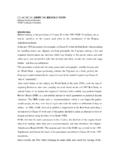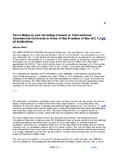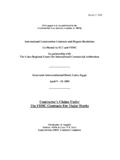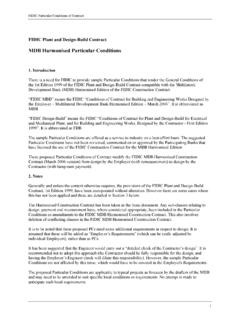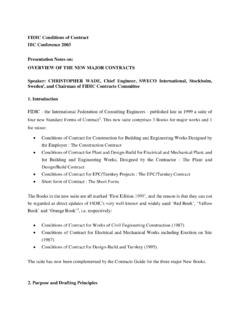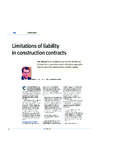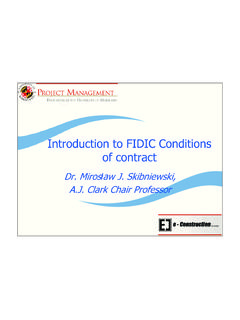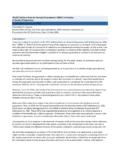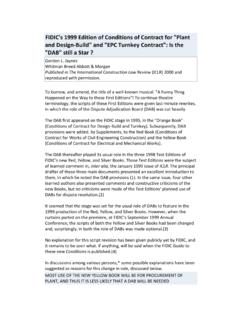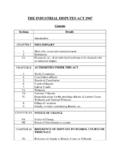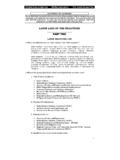Transcription of FIDIC'S NEW STANDARD FORMS OF CONTRACT
1 FIDIC'S NEW STANDARD FORMS OF CONTRACT FORCE MAJEURE, CLAIMS, disputes AND OTHER CLAUSES Seppala, Legal Adviser, FIDIC Task Group for updating the FL9IC International Conditions of CONTRACT , partner, White & Case LLP, Paris This article is divided into two parts. Part I discusses FIDIC'S three new Books for major works1 in relation to: 1 Contractor's risk and "Employer's Risk"2 2 indemnities; 3 limitation of liability; 4 the new force majeure Clause; and 5 grounds and procedure for termination of the CONTRACT by the Employer and the Contractor.
2 Part II looks at: 1 the new procedures for claims of the Contractor and the Employer; 2 the procedure for the settlement of disputes by the Dispute adjudication board (DAB); and 3 very briefly, international arbitration. Part I: Risks, Force Majeure and Termination CONTRACTOR'S RISK AND "EMPLOYER'S RISK" (ALLOCATION OF RESPONSIBILITY FOR DAMAGE TO THE WORKS) (Sub-Clauses to ) The basic allocation of risk between the Contractor and the Employer for damage to the Works before takeover is dealt with in Sub-Clauses to of the new Books.
3 The principles are essentially unchanged from those in the old Red and Orange Books. These principles (it will be recalled) are as follows: 1. The Contractor is required to take full responsibility for the care of the Works, materials and Plant from the Commencement Date until the Taking-Over Certificate is issued for the Works. 2. If any loss or damage happens to the Works or materials and Plant, other than due to Employer s Risk (as defined), the Contractor must rectify this loss or damage at the Contractor s cost.
4 3. "Employer's Risks" are generally events or circumstances over which neither party will have any control ( war, hostilities and the like) or events or circumstances caused by the Employer, directly or indirectly. Under the new Books, the Contractor's responsibility before takeover now extends not merely to the Works, materials and Plant but, in addition, to: 1. "Goods": a new defined term in the new Books-which would include Contractor's Equipment, whether on or off the Site; and 2. "Contractor's Documents": also a new term-which would include computer software and documents of a technical nature supplied by the Contractor.
5 The Employer's Risks in the new Construction CONTRACT and Plant CONTRACT , which are defined in Sub-Clause , are similar to those in the old Red and Orange Books: The list of the Employer's Risks in the EPC CONTRACT is more limited. It only includes paragraphs (a) through (e). Thus, use or occupation of the Works by the Employer (paragraph (f)), design of the Works by the Employer's Personnel (paragraph (g)) and "Unforeseeable" operations of the forces of nature (paragraph (h) ), are not recognised as Employer's Risks in the EPC CONTRACT , in keeping with the risk allocation philosophy of that Book, under which more risk is allocated to the Contractor.
6 As was the case under the old Red and Orange Books, _f the Works suffer loss or damage due to an Einpkner's Risk, the Contractor must rectify this loss or damage to the extent required by the Employer or the Engineer. Where the Employer or the Engineer requires rectification and the Contractor suffers delay and/or incurs additional cost, the Contractor may be entitled to an extension of time and to the cost of rectification (Sub-Clause ). Where the Contractor rectifies Works which have been lost or damaged as the result of an Employer's Risk, is the Contractor entitled to recover profit in addition to the cost of rectification?
7 In the past, FIDIC his taken different positions on this: 1. Under the old Red Book (Sub-Clause ), the Contractor was entitled in all cases of Employer's Risks to "an addition to the CONTRACT Price in accordance with Clause 52", implying he i,; entitled to profit. 2. However, under the Orange Book (Sub-Clause ), the contractor was entitled in all cases only to cost, implying he is not entitled to profit. The new Books take an intermediate position.
8 In general, the Contractor is only entitled to recover his cost, but in the case of paragraph (f) (use or occupation by the Employer), and paragraph (g) (design by the Employer), the Contractor is entitled to "reasonable profit" as well. The theory here is that these are cases where the Employer is, in effect, in ')reach of CONTRACT and, therefore, the Contractor should be entitled to recover his profit, whereas in the other cases the Employer is not at fault and, therefore, there should be some sharing of risk by the Contractor, by his giving up an entitlement to profit.
9 As paragraphs (f) and (g) are not contained in the list of Employer's Risks in the EPC CONTRACT , the issue of entitlement to profit does not arise at all in relation to that Book. INDEMNITIES (Sub-Clause ) Under the old Red Book, not only was the Contractor responsible for the care of the Works, from the Commencement Date until takeover, but he was also to a certain extent responsible for things that arose out of or as a consequence of his execution of the Works or remedying of any defects therein. Thus, if the Employer were subject to losses or claims for: (a) death or injury to any person; or (b) loss or damage to any property (other than the Works) arising out of, or as a consequence of, the performance of the Contractor's duties, the Contractor was required to indemnify the Employer against such claims or losses (Sub-Clause ) subject to certain exceptions (Sub-Clause ).
10 The Orange Book contains a somewhat similar indemnity ( ). Under. the new Books, the Contractor continues to be responsible for losses or claims that arise out of, or as a consequence of, the Contractor's design (if any) and execution of the Works and remedying defects. However, while the Contractor must indemnify the Employer for losses or claims for bodily injury, disease or death of any person, regardless of whether or not the Contractor was negligent (unless positively caused by the Employer or his agents) recognizing the Contractor's overriding control over Site operations, the Contractor is only liable to indemnify the Employer for property damage where the Contractor has been negligent or committed a breach of CONTRACT (Sub-Clause (b)).
